load capacity lexus LC500C 2021 Owner's Manual / LEXUS 2021 LC500 CONVERTIBLE OWNER'S MANUAL (OM11498U)
[x] Cancel search | Manufacturer: LEXUS, Model Year: 2021, Model line: LC500C, Model: Lexus LC500C 2021Pages: 410, PDF Size: 8.71 MB
Page 144 of 410
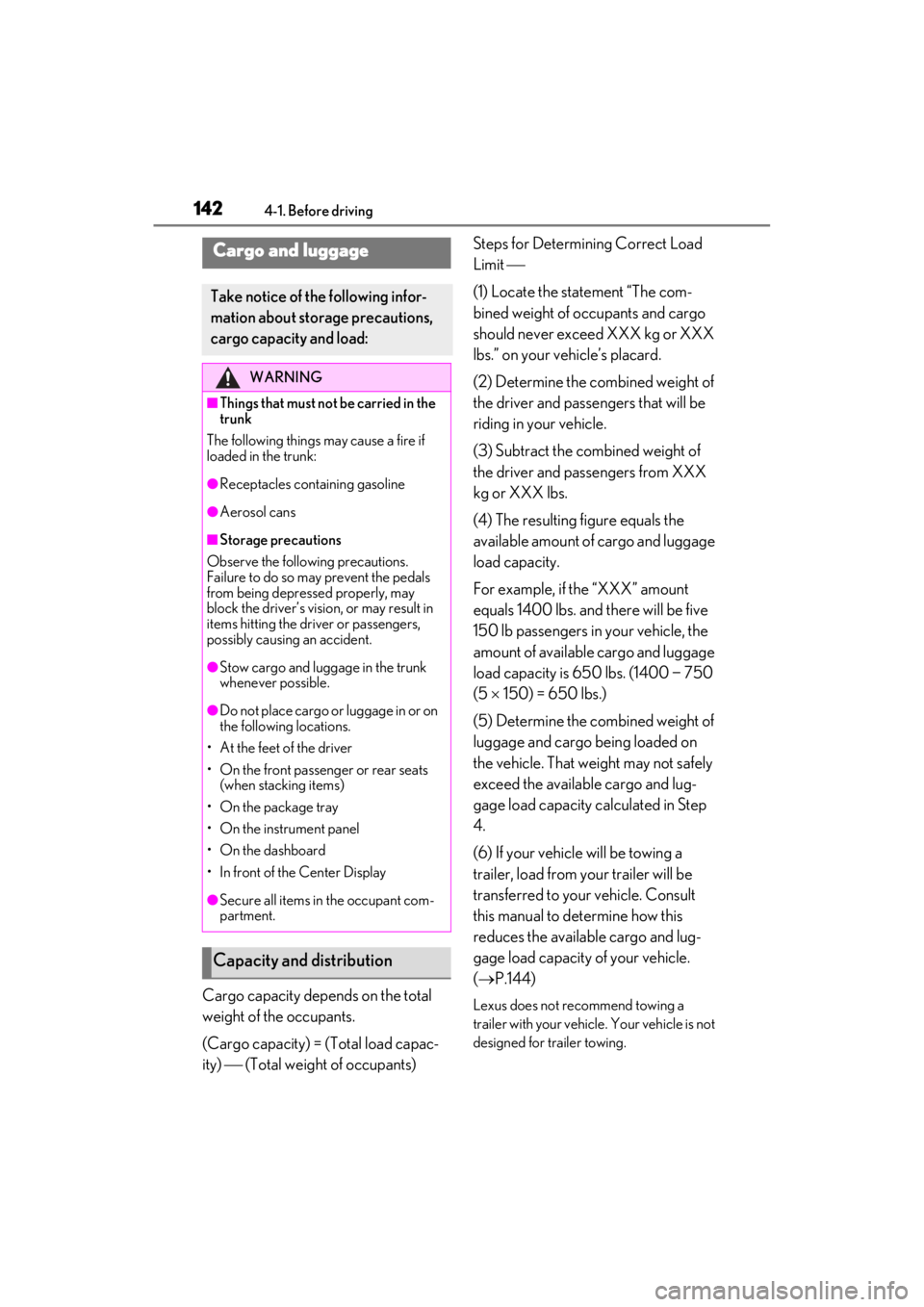
1424-1. Before driving
Cargo capacity depends on the total
weight of the occupants.
(Cargo capacity) = (Total load capac-
ity) (Total weight of occupants)Steps for Determining Correct Load
Limit
(1) Locate the statement “The com-
bined weight of occupants and cargo
should never exceed XXX kg or XXX
lbs.” on your vehicle’s placard.
(2) Determine the combined weight of
the driver and passengers that will be
riding in your vehicle.
(3) Subtract the combined weight of
the driver and passengers from XXX
kg or XXX lbs.
(4) The resulting figure equals the
available amount of cargo and luggage
load capacity.
For example, if the “XXX” amount
equals 1400 lbs. and there will be five
150 lb passengers in your vehicle, the
amount of available cargo and luggage
load capacity is 650 lbs. (1400 − 750
(5 150) = 650 lbs.)
(5) Determine the combined weight of
luggage and cargo being loaded on
the vehicle. That weight may not safely
exceed the available cargo and lug-
gage load capacity calculated in Step
4.
(6) If your vehicle will be towing a
trailer, load from your trailer will be
transferred to your vehicle. Consult
this manual to determine how this
reduces the available cargo and lug-
gage load capacity of your vehicle.
( P.144)Lexus does not recommend towing a
trailer with your vehicle. Your vehicle is not
designed for trailer towing.
Cargo and luggage
Take notice of the following infor-
mation about storage precautions,
cargo capacity and load:
WARNING
■Things that must not be carried in the
trunk
The following things may cause a fire if
loaded in the trunk:
●Receptacles containing gasoline
●Aerosol cans
■Storage precautions
Observe the following precautions.
Failure to do so may prevent the pedals
from being depressed properly, may
block the driver’s vision, or may result in
items hitting the driver or passengers,
possibly causing an accident.
●Stow cargo and luggage in the trunk
whenever possible.
●Do not place cargo or luggage in or on
the following locations.
• At the feet of the driver
• On the front passenger or rear seats (when stacking items)
• On the package tray
• On the instrument panel
• On the dashboard
• In front of the Center Display
●Secure all items in the occupant com-
partment.
Capacity and distribution
Page 145 of 410
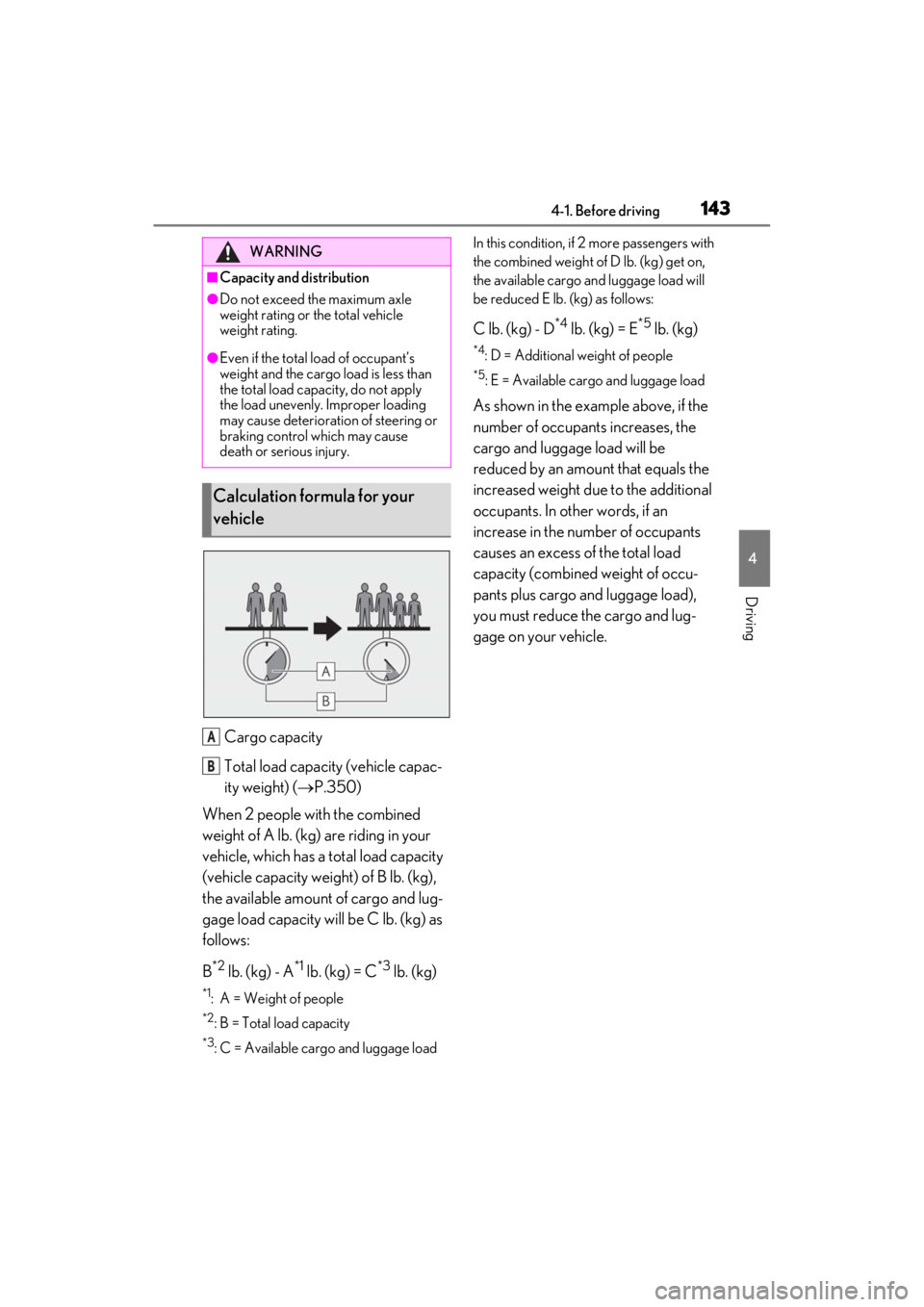
1434-1. Before driving
4
Driving
Cargo capacity
Total load capacity (vehicle capac-
ity weight) (P.350)
When 2 people with the combined
weight of A lb. (kg) are riding in your
vehicle, which has a total load capacity
(vehicle capacity weight) of B lb. (kg),
the available amount of cargo and lug-
gage load capacity will be C lb. (kg) as
follows:
B
*2 lb. (kg) - A*1 lb. (kg) = C*3 lb. (kg)
*1: A = Weight of people
*2: B = Total load capacity
*3: C = Available cargo and luggage load In this condition, if 2 more passengers with
the combined weight of D lb. (kg) get on,
the available cargo and luggage load will
be reduced E lb. (kg) as follows:
C lb. (kg) - D*4 lb. (kg) = E*5 lb. (kg)
*4: D = Additional weight of people
*5: E = Available cargo and luggage load
As shown in the example above, if the
number of occupant
s increases, the
cargo and luggage load will be
reduced by an amount that equals the
increased weight due to the additional
occupants. In other words, if an
increase in the number of occupants
causes an excess of the total load
capacity (combined weight of occu-
pants plus cargo and luggage load),
you must reduce the cargo and lug-
gage on your vehicle.
WARNING
■Capacity and distribution
●Do not exceed the maximum axle
weight rating or the total vehicle
weight rating.
●Even if the total load of occupant’s
weight and the cargo load is less than
the total load capacity, do not apply
the load unevenly. Improper loading
may cause deterioration of steering or
braking control which may cause
death or serious injury.
Calculation formula for your
vehicle
A
B
Page 146 of 410

1444-1. Before driving
■Total load capacity and seating capacity
These details are also described on the tire
and loading information label. ( P.293)
Vehicle load limits
Vehicle load limits include total
load capacity, seating capacity,
towing capacity and cargo capac-
ity.
Total load capacity (vehicle
capacity weight): P.350
Total load capacity means the com-
bined weight of occupants, cargo
and luggage.
Seating capacity: P.350
Seating capacity means the maxi-
mum number of occupants whose
estimated average weight is 150 lb.
(68 kg) per person.
Towing capacity
Lexus does not recommend towing
a trailer with your vehicle.
Cargo capacity
Cargo capacity may increase or
decrease depending on the weight
and the number of occupants.
WARNING
■Overloading the vehicle
Do not overload the vehicle.
It may not only cause damage to the tires,
but also degrade steering and braking
ability, resulting in an accident.
Trailer towing
Lexus does not recommend towing
a trailer with your vehicle. Lexus
also does not recommend the
installation of a tow hitch or the use
of a tow hitch carrier for a wheel-
chair, scooter, bicycle, etc. Your
vehicle is not designed for trailer
towing or for the use of tow hitch
mounted carriers.
Page 224 of 410

2224-5. Using the driving support systems
WARNING
■Active Cornering Assist does not
operate effectively when
●Do not overly rely on Active Corner-
ing Assist. Active Cornering Assist
may not operate effectively when
accelerating down slopes or driving on
slippery road surfaces.
●When Active Cornering Assist fre-
quently operates, Active Cornering
Assist may temporarily stop operating
to ensure proper operation of the
brakes, TRAC and VSC.
■Hill- start assist control does not
operate effectively when
●Do not overly rely on hill-start assist
control. Hill-start assist control may
not operate effectively on steep
inclines and roads covered with ice.
●Unlike the parking brake, hill-start
assist control is not intended to hold
the vehicle stationary for an extended
period of time. Do not attempt to use
hill-start assist control to hold the vehi-
cle on an incline, as doing so may lead
to an accident.
■When the TRAC/ABS/ VSC is acti-
vated
The slip indicator light flashes. Always
drive carefully. Re ckless driving may
cause an accident. Exercise particular
care when the indicator light flashes.
■When the TRAC/VSC systems are
turned off
Be especially careful and drive at a
speed appropriate to the road condi-
tions. As these are the systems to help
ensure vehicle stability and driving force,
do not turn the TRAC/VSC systems off
unless necessary.
■Replacing tires
Make sure that all ti res are of the speci-
fied size, brand, tread pattern and total
load capacity. In addition, make sure that
the tires are inflated to the recom-
mended tire inflation pressure level.
The ABS, TRAC and VSC systems will
not function correctly if different tires are
installed on the vehicle.
Contact your Lexus dealer for further
information when replacing tires or
wheels.
■Handling of tires and the suspension
Using tires with any kind of problem or
modifying the suspensi on will affect the
driving assist systems, and may cause a
system to malfunction.
■Secondary Collision Brake
Do not rely solely upon the Secondary
Collision Brake. This system is designed
to help reduce the possibility of further
damage due to a secondary collision,
however, that effect changes according
to various conditions. Overly relying on
the system may result in death or serious
injury.
Page 284 of 410
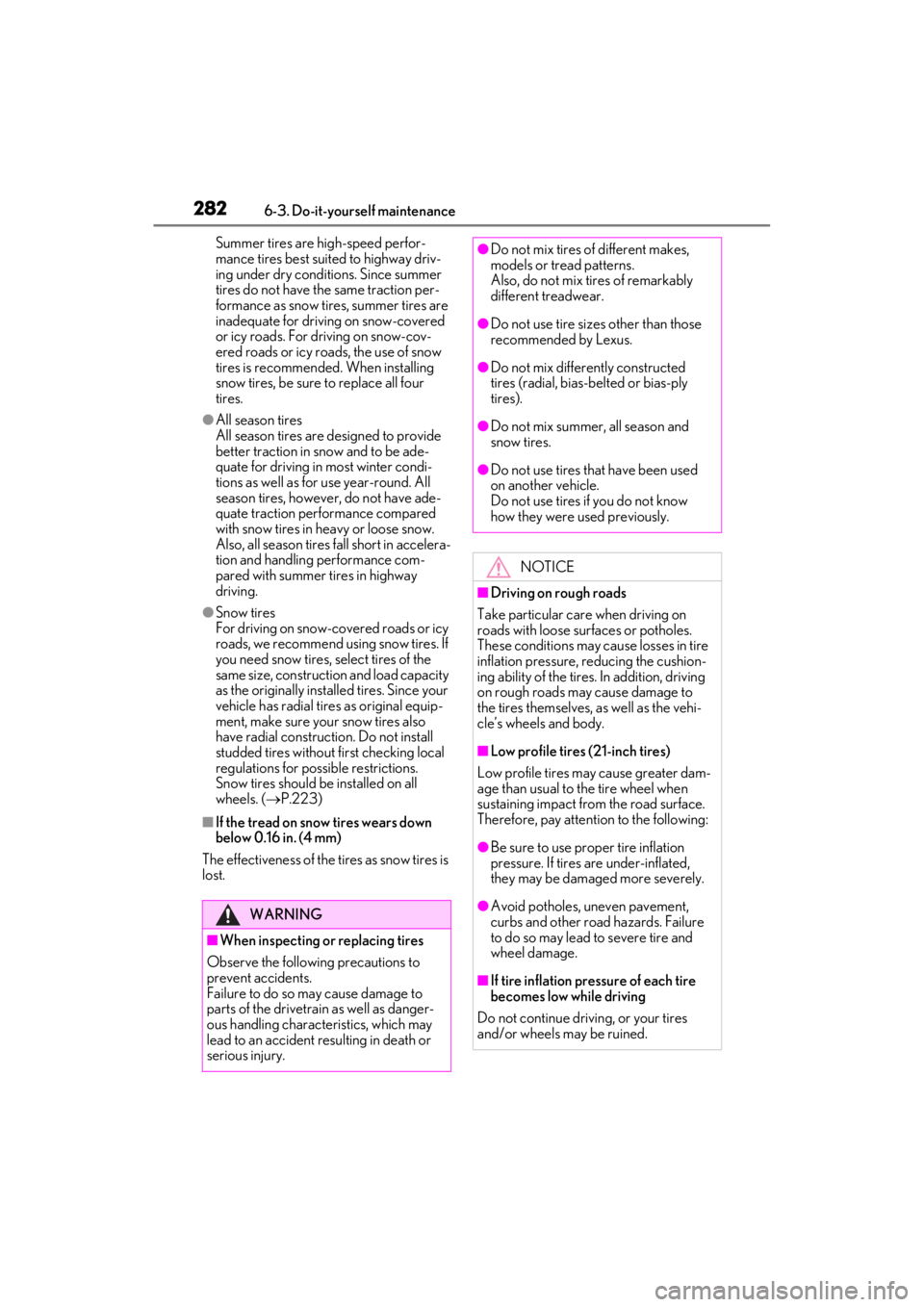
2826-3. Do-it-yourself maintenance
Summer tires are high-speed perfor-
mance tires best suited to highway driv-
ing under dry conditions. Since summer
tires do not have the same traction per-
formance as snow tires, summer tires are
inadequate for driving on snow-covered
or icy roads. For driving on snow-cov-
ered roads or icy roads, the use of snow
tires is recommended. When installing
snow tires, be sure to replace all four
tires.
●All season tires
All season tires are designed to provide
better traction in snow and to be ade-
quate for driving in most winter condi-
tions as well as for use year-round. All
season tires, however, do not have ade-
quate traction performance compared
with snow tires in heavy or loose snow.
Also, all season tires fall short in accelera-
tion and handling performance com-
pared with summer tires in highway
driving.
●Snow tires
For driving on snow-covered roads or icy
roads, we recommend using snow tires. If
you need snow tires, select tires of the
same size, construction and load capacity
as the originally installed tires. Since your
vehicle has radial tires as original equip-
ment, make sure your snow tires also
have radial construction. Do not install
studded tires without first checking local
regulations for possible restrictions.
Snow tires should be installed on all
wheels. ( P.223)
■If the tread on snow tires wears down
below 0.16 in. (4 mm)
The effectiveness of the tires as snow tires is
lost.
WARNING
■When inspecting or replacing tires
Observe the following precautions to
prevent accidents.
Failure to do so may cause damage to
parts of the drivetrain as well as danger-
ous handling characteristics, which may
lead to an accident resulting in death or
serious injury.
●Do not mix tires of different makes,
models or tread patterns.
Also, do not mix tires of remarkably
different treadwear.
●Do not use tire sizes other than those
recommended by Lexus.
●Do not mix differently constructed
tires (radial, bias-belted or bias-ply
tires).
●Do not mix summer, all season and
snow tires.
●Do not use tires that have been used
on another vehicle.
Do not use tires if you do not know
how they were used previously.
NOTICE
■Driving on rough roads
Take particular care when driving on
roads with loose surfaces or potholes.
These conditions may cause losses in tire
inflation pressure, reducing the cushion-
ing ability of the tires. In addition, driving
on rough roads may cause damage to
the tires themselves, as well as the vehi-
cle’s wheels and body.
■Low profile tires (21-inch tires)
Low profile tires may cause greater dam-
age than usual to the tire wheel when
sustaining impact from the road surface.
Therefore, pay attention to the following:
●Be sure to use proper tire inflation
pressure. If tires are under-inflated,
they may be damaged more severely.
●Avoid potholes, uneven pavement,
curbs and other road hazards. Failure
to do so may lead to severe tire and
wheel damage.
■If tire inflation pressure of each tire
becomes low while driving
Do not continue driving, or your tires
and/or wheels may be ruined.
Page 354 of 410
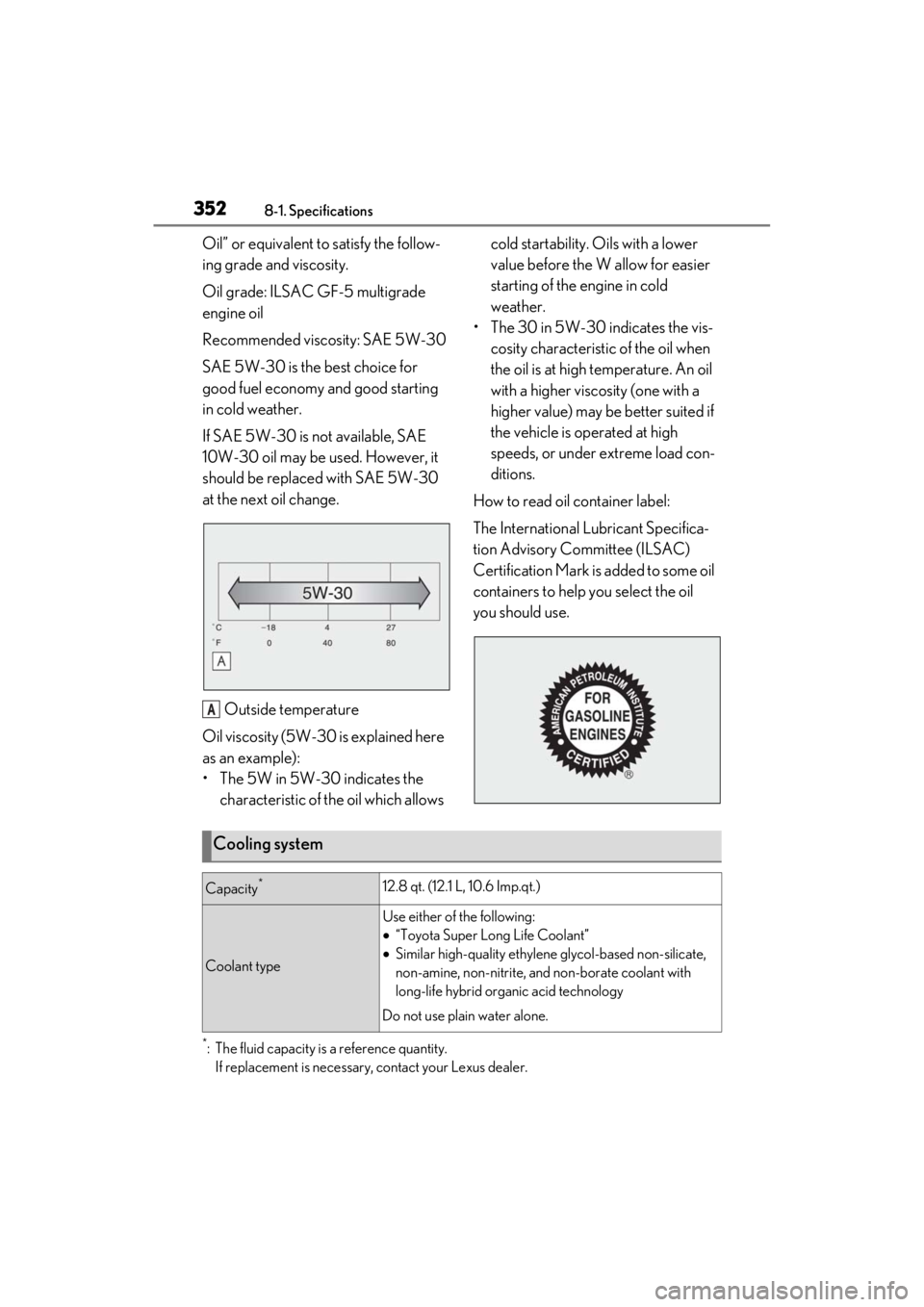
3528-1. Specifications
Oil” or equivalent to satisfy the follow-
ing grade and viscosity.
Oil grade: ILSAC GF-5 multigrade
engine oil
Recommended viscosity: SAE 5W-30
SAE 5W-30 is the best choice for
good fuel economy and good starting
in cold weather.
If SAE 5W-30 is not available, SAE
10W-30 oil may be used. However, it
should be replaced with SAE 5W-30
at the next oil change.Outside temperature
Oil viscosity (5W-30 is explained here
as an example):
• The 5W in 5W-30 indicates the characteristic of the oil which allows cold startability. Oils with a lower
value before the W allow for easier
starting of the engine in cold
weather.
• The 30 in 5W-30 indicates the vis- cosity characteristic of the oil when
the oil is at high temperature. An oil
with a higher viscosity (one with a
higher value) may be better suited if
the vehicle is operated at high
speeds, or under extreme load con-
ditions.
How to read oil container label:
The International Lubricant Specifica-
tion Advisory Committee (ILSAC)
Certification Mark is added to some oil
containers to help you select the oil
you should use.
*: The fluid capacity is a reference quantity. If replacement is necessary, contact your Lexus dealer.
A
Cooling system
Capacity*12.8 qt. (12.1 L, 10.6 Imp.qt.)
Coolant type
Use either of the following:
“Toyota Super Long Life Coolant”
Similar high-quality ethylene glycol-based non-silicate,
non-amine, non-nitrite, and non-borate coolant with
long-life hybrid orga nic acid technology
Do not use plain water alone.
Page 365 of 410
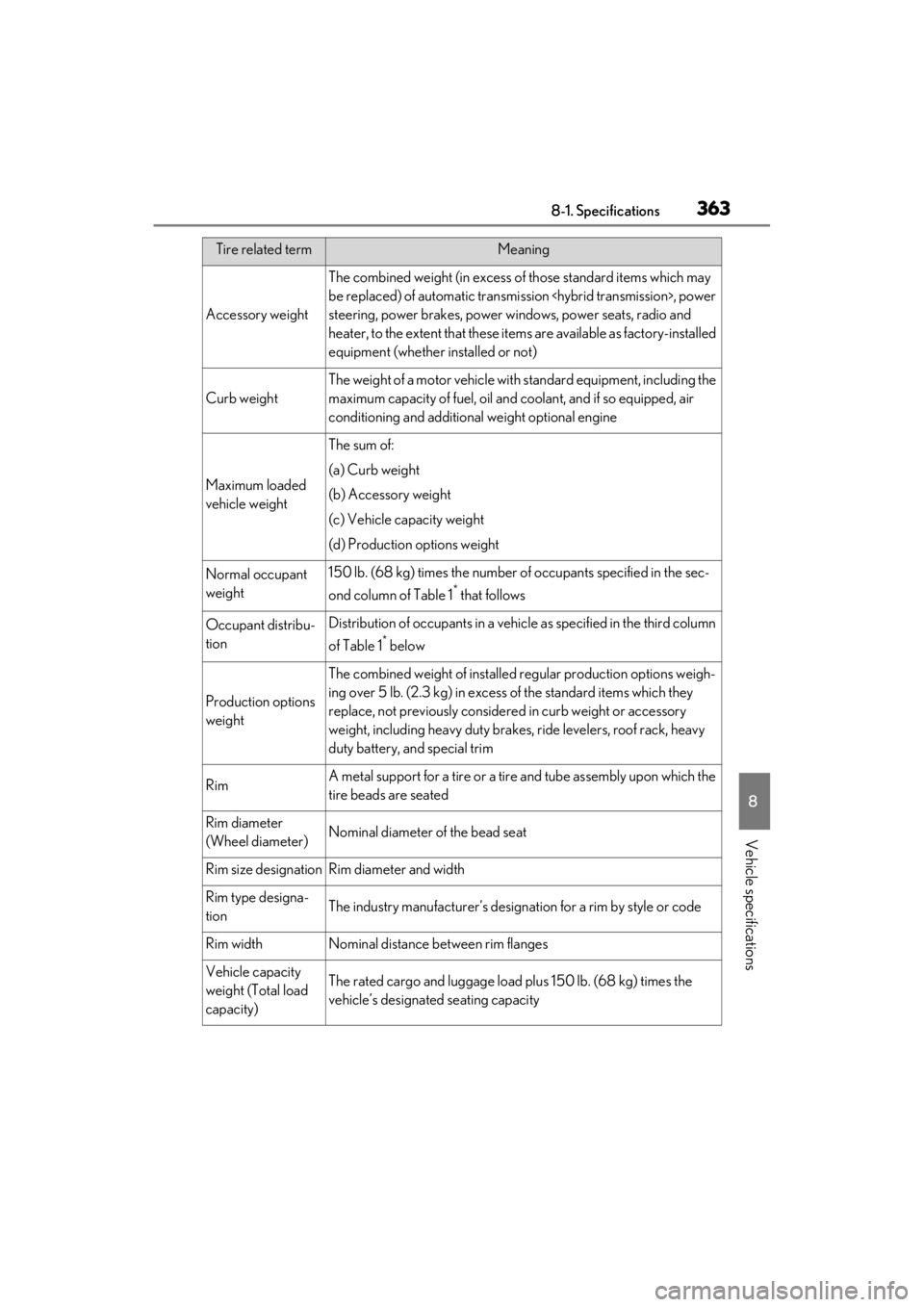
3638-1. Specifications
8
Vehicle specifications
Accessory weight
The combined weight (in excess of those standard items which may
be replaced) of automatic transmission
steering, power brakes, power wi ndows, power seats, radio and
heater, to the extent that these item s are available as factory-installed
equipment (whether installed or not)
Curb weight
The weight of a motor vehicle with standard equipment, including the
maximum capacity of fuel, oil and coolant, and if so equipped, air
conditioning and additional weight optional engine
Maximum loaded
vehicle weight
The sum of:
(a) Curb weight
(b) Accessory weight
(c) Vehicle capacity weight
(d) Production options weight
Normal occupant
weight150 lb. (68 kg) times the number of occupants specified in the sec-
ond column of Table 1
* that follows
Occupant distribu-
tionDistribution of occupants in a vehicl e as specified in the third column
of Table 1
* below
Production options
weight
The combined weight of installed regular production options weigh-
ing over 5 lb. (2.3 kg) in excess of the standard items which they
replace, not previously considered in curb weight or accessory
weight, including heavy duty brakes , ride levelers, roof rack, heavy
duty battery, and special trim
RimA metal support for a tire or a tire and tube assembly upon which the
tire beads are seated
Rim diameter
(Wheel diameter)Nominal diameter of the bead seat
Rim size designationRim diameter and width
Rim type designa-
tionThe industry manufacturer’s designation for a rim by style or code
Rim widthNominal distance between rim flanges
Vehicle capacity
weight (Total load
capacity)The rated cargo and luggage load plus 150 lb. (68 kg) times the
vehicle’s designated seating capacity
Tire related termMeaning
Page 368 of 410
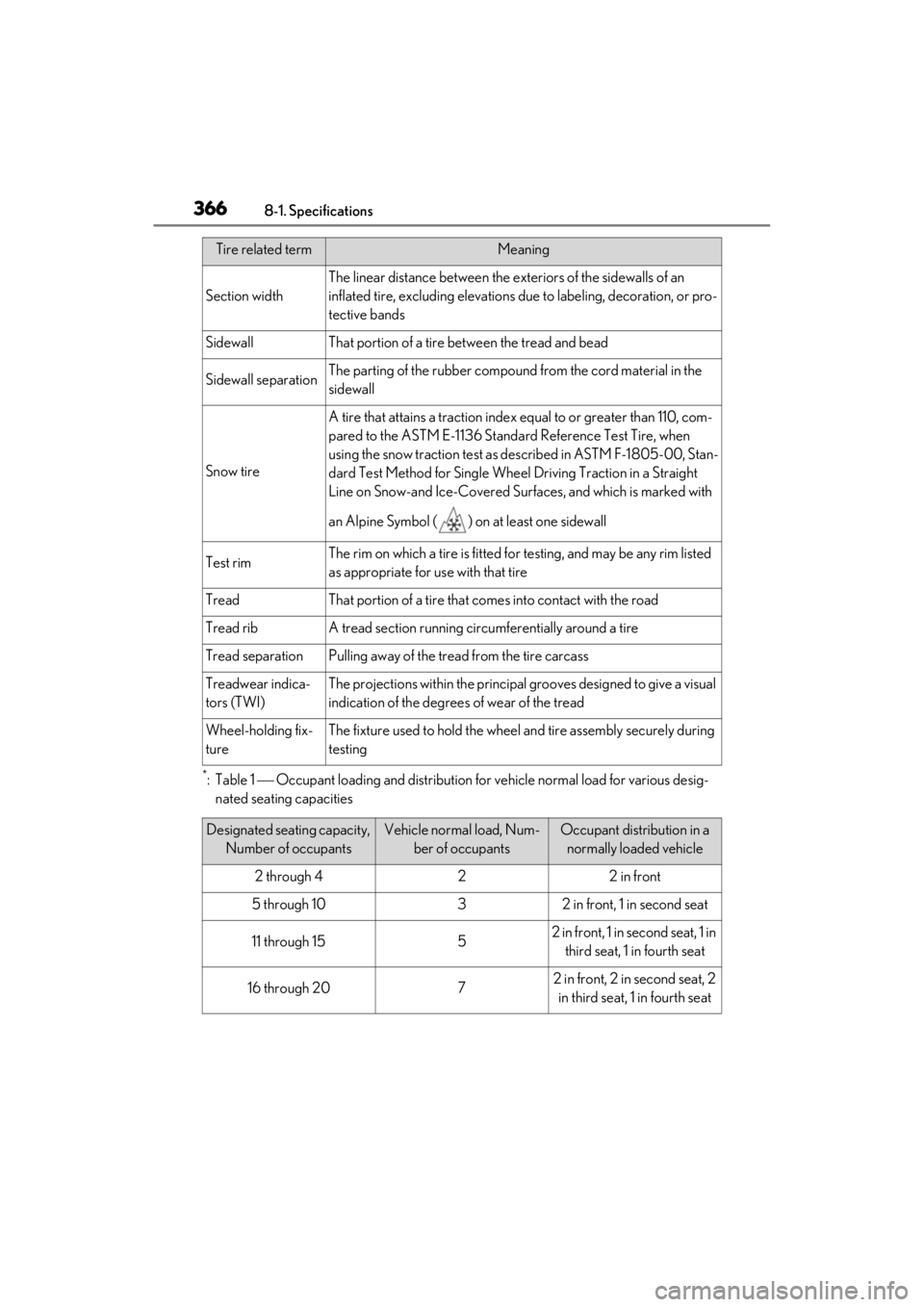
3668-1. Specifications
*:Table 1 Occupant loading and distribution for vehicle normal load for various desig-
nated seating capacities
Section width
The linear distance between the exteriors of the sidewalls of an
inflated tire, excluding elevations due to labeling, decoration, or pro-
tective bands
SidewallThat portion of a tire between the tread and bead
Sidewall separationThe parting of the rubber compound from the cord material in the
sidewall
Snow tire
A tire that attains a traction index equal to or greater than 110, com-
pared to the ASTM E-1136 Standa rd Reference Test Tire, when
using the snow traction test as de scribed in ASTM F-1805-00, Stan-
dard Test Method for Single Whee l Driving Traction in a Straight
Line on Snow-and Ice-Covered Surf aces, and which is marked with
an Alpine Symbol ( ) on at least one sidewall
Test rimThe rim on which a tire is fitted fo r testing, and may be any rim listed
as appropriate for use with that tire
TreadThat portion of a tire that comes into contact with the road
Tread ribA tread section running circumferentially around a tire
Tread separationPulling away of the tread from the tire carcass
Treadwear indica-
tors (TWI)The projections within th e principal grooves designed to give a visual
indication of the degree s of wear of the tread
Wheel-holding fix-
tureThe fixture used to hold the wheel and tire assembly securely during
testing
Designated seating capacity,
Number of occupantsVehicle normal load, Num- ber of occupantsOccupant distribution in a normally loaded vehicle
2 through 422 in front
5 through 1032 in front, 1 in second seat
11 through 1552 in front, 1 in second seat, 1 in
third seat, 1 in fourth seat
16 through 2072 in front, 2 in second seat, 2 in third seat, 1 in fourth seat
Tire related termMeaning
Page 405 of 410

Alphabetical index403
Alarm .................................................................. 65
Engine immobilizer system ..................... 63
Theft prevention labels............................... 67
Tire inflation pressure ................................ 293 Maintenance data......................................355
Tire inflation pressu re display function
......................................................................... 283
Warning light .................................................319
Tire information ............................................ 359 Glossary......................................................... 362
Size....................................................................360
Tire identification number .....................360
Uniform Tire Quality Grading..............361
Tire pressure warning system ................ 283 Function .......................................................... 283
Initializing .......................................................286
Installing tire pressure warning valves and transmitters ......................................285
Registering ID codes ............................... 287
Warning light .................................................319
Tires.....................................................................281 Chains ............................................................. 224
Checking .........................................................281
If you have a flat tire .................................. 327
Inflation pressure........................................ 293
Information ....................................................359
Replacing .......................................................289
Rotating tires ................................................ 283
Run-flat tires ..................................... 283, 327
Size....................................................................355
Snow tires ...................................................... 223
Tire inflation pressu re display function
......................................................................... 283
Tire pressure warning system ............. 283
Warning light .................................................319
Tools...................................................... 289, 339
Total load capacity ....... ............................... 350
Towing Dinghy towing ...............................................145
Emergency towing ...................................309
Towing eyelet ................................................. 311
Trailer towing ................................................. 144 TRAC (Traction Control) ..........................218
Traction Control (TRAC) ..........................218
Trailer towing ..................................................144
Transmission
Automatic transmission ........................... 150
Driving mode select switch ..................203
M mode ........................................................... 155
Paddle shift switches .......................154, 155
Snow mode.................................................... 154
Trip meters ........................................................ 75
Trunk .................................................................. 100 Internal trunk release lever..................... 102
Smart access system with push-button start ................................................................... 101
Trunk features ..............................................248
Trunk grip ....................................................... 102
Trunk light ....................................................... 102
Trunk opener main switch...................... 103
Trunk opener switch ................................... 101
Wireless remote control ......................... 102
Trunk light .........................................................102
Turn signal lights ............................................156 Replacing light bulbs ............................... 303
Turn signal lever .......................................... 156
U
Units .......................................................................81
V
Vanity lights.................................................... 249Wattage ......................................................... 356
Vanity mirrors ............................................... 249
VDIM (Vehicle Dynamics Integrated Management) ..............................................219
Vehicle data recordings ..................................6
Vehicle Dynamics Integrated Manage- ment (VDIM)................................................219
Vehicle identification number ................350
Vehicle Stability Control (VSC) .............218
Ventilators (seat ventilators)................... 240
VSC (Vehicle Stability Control) .............218
Page 406 of 410

404Alphabetical index
W
Warning buzzersApproach warning......................................199
Brake system ................................................. 314
Downshifting .......................................155, 156
Intuitive parking assist..............................209
LKA (Lane-Keeping Assist).................. 186
Open door.............................................. 97, 99
Open hood...................................................... 99
Open soft top roof...................................... 127
Open trunk ...................................................... 99
Open window ............................................... 124
Pre-collision braking.................................. 179
Seat belt reminder...................................... 318
Warning lights.................................................314 ABS ....................................................................315
Brake hold operated indicator ............. 317
Brake Override System ........................... 317
Brake system ...................................... 314, 318
Charging system ......................................... 314
Electric power steering ............................315
High coolant temperature ......................319
LKA (Lane-Keeping Assist)...................316
Low engine oil pressure...........................314
Low fuel level ................................................ 318
Malfunction indicator lamp.....................315
Master warning light ..................................319
Parking brake indicator ............................ 317
Pre-collision system ...................................316
Seat belt reminder light ........................... 318
Slip indicator ..................................................316
SRS......................................................................315
Tire pressure ..................................................319
Warning messages ..................................... 323
Warning reflector storag e belt.............. 248
Washer .............................................................. 167 Checking ....................................................... 278
Preparing and checking before winter......................................................................... 223
Switch ................................................................ 167
Washing and waxing.................................. 258 Weight
Cargo capacity .............................................144
Load limits .......................................................144
Weight............................................................ 350
Wheels ............................................................. 295 Replacing wheels ...................................... 289
Size ................................................................... 355
Window lock switch .....................................125
Windows ........................................................... 122 Power windows ............................................ 122
Rear quarter windows ............................... 122
Rear window defogger........................... 233
Side windows................................................. 122
Washer .............................................................167
Windshield wiper de-icer ........................ 237
Windshield wipers ........................................ 167 Position............................................................. 169
Rain-sensing windshield wipers ...........167
Winter driving tips....................................... 223
Wireless remote control ............................. 94 Battery-Saving Function.......................... 104
Locking/Unlocking ..................................... 94
Replacing the battery ............................... 297
For information regarding the equipment listed below, refer to
the “NAVIGATION SYSTEM
OWNER’S MANUAL”.
· Audio/video system
· Navigation system
· Lexus parking assist monitor
· Lexus Enform